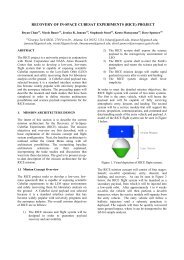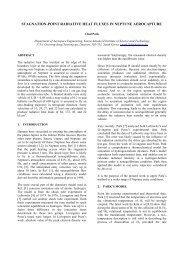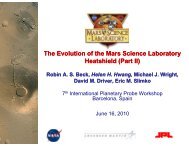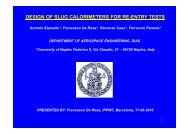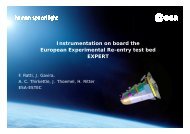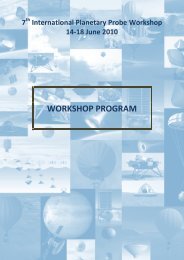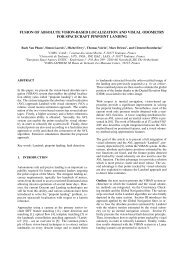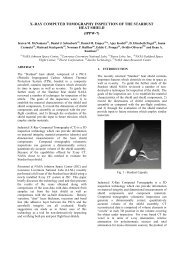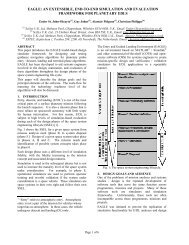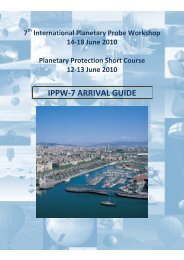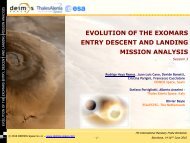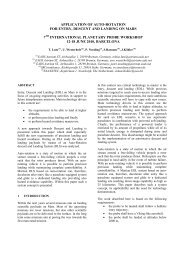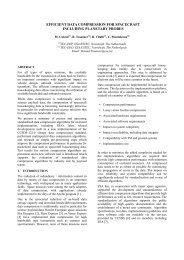Paper 342 - International Planetary Probe Workshop
Paper 342 - International Planetary Probe Workshop
Paper 342 - International Planetary Probe Workshop
Create successful ePaper yourself
Turn your PDF publications into a flip-book with our unique Google optimized e-Paper software.
3.3 Lake Lander<br />
The orbiter spacecraft would also carry the lake lander<br />
in its aeroshell and release it during the second Titan<br />
flyby. After releasing the lander, the orbiter would be in<br />
continuous contact with it, allowing the orbiter to<br />
monitor the lander’s trajectory and to collect and relay<br />
to Earth all telemetry data.<br />
Entry and descent would largely build upon heritage<br />
from Huygens, and the early phases would be similar to<br />
those described for the montgolfière above. Unlike<br />
Huygens, in the TSSM baseline, the lander would<br />
descend on a single main parachute, thus spending more<br />
time in descent (approximately 5 hours) while<br />
performing atmospheric analysis of high northern<br />
latitudes. The floating lander design would provide<br />
enough energy to perform scientific measurements for<br />
3–4 hours after landing in the lake.<br />
Table 3. Model instruments for the montgolfière.<br />
Inst. Description Science Contributions<br />
BIS Balloon Imaging<br />
Spectrometer<br />
(1–5.6 µm).<br />
Mapping for troposphere<br />
and surface composition<br />
at 2.5 m resolution<br />
VISTA-B<br />
ASI/<br />
MET<br />
TEEP-B<br />
TRS<br />
TMCA<br />
Visual Imaging<br />
System with two<br />
wide angle<br />
stereo cameras<br />
& one narrow<br />
angle camera.<br />
Atmospheric<br />
Structure<br />
Instrument and<br />
Meteorological<br />
Package.<br />
Titan Electric<br />
Environment<br />
Package<br />
> 150 MHz<br />
radar sounder<br />
1-600 Da Mass<br />
spectrometer<br />
Copyright 2010. All rights reserved<br />
Detailed geomorphology<br />
at 1 m resolution<br />
Record atmosphere<br />
characteristics &<br />
determine wind velocities<br />
in the equatorial<br />
troposphere<br />
Measure electric field in<br />
the troposphere (0–<br />
10 kHz) and determine<br />
connection with weather.<br />
Detection of shallow<br />
reservoirs of<br />
hydrocarbons, depth of<br />
icy crust and better than<br />
10 m resolution<br />
stratigraphic of<br />
geological features.<br />
Analysis of aerosols and<br />
determination of noble<br />
gases concentration and<br />
ethane/methane ratios in<br />
the troposphere<br />
MAG Magnetometer Separate internal and<br />
external sources of the<br />
field and determine<br />
whether Titan has an<br />
intrinsic and/or induced<br />
magnetic field.<br />
MRST<br />
Radio Science<br />
using spacecraft<br />
telecom system<br />
Precision tracking of the<br />
montgolfière<br />
6<br />
Fig. 10 shows a conceptual design of the lander and an<br />
exploded view of the stowed configuration.<br />
Accommodating instrumentation and system support<br />
equipment inside the lander aids optimizing thermal<br />
balance. Environmental sensors and an omni-directional<br />
antenna would be mounted on the upper side (Fig. 10).<br />
The lander’s total launch mass is estimated at 190 kg,<br />
including 32 kg of science instrumentation as listed in<br />
Table 4.<br />
4. PATH FORWARD<br />
Following completion of the TSSM study in 2008,<br />
NASA and ESA review panels evaluated the concept<br />
and identified risks that would need further attention to<br />
enable the mission to proceed. The NASA panel<br />
focused primarily on the NASA-provided orbiter and<br />
identified a number of risks to the design presented in<br />
the study that would require future action. Review by<br />
the TSSM design team recognized these risks, but<br />
determined that they are not out of the norm for<br />
missions at this stage of development and saw no “tall<br />
tent poles” requiring significant additional investment at<br />
this time.<br />
The ESA review panel identified a number of risks,<br />
primarily related to development of the montgolfière,<br />
the one element of TSSM that is truly unique to this<br />
mission concept. A number of these technical risks were<br />
determined by the TSSM team to be excellent<br />
candidates for early mitigation activities. These<br />
included:<br />
• Balloon deployment and inflation upon arrival at<br />
Titan<br />
• Balloon packaging and thermal management inside<br />
the aeroshell during cruise<br />
Fig. 10. Conceptual design of the lake lander in the<br />
stowed configuration. An exploded view of the Huygens<br />
heritage entry aeroshell is shown



